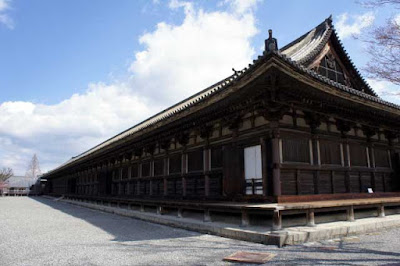Sanjusangengo Temple Area

?????
Nestled long and low behind the earthen walls that separate it from the noise of the city, Sanjusangendo is a national treasure temple of unique architectural and sculptural importance. First dedicated in 1164 by Emperor Goshirakawa (1127-92) within his retirement estate, the Hojuji Dono, Sanjusangendo is one of the few architectural remnants of the turbulent era that ended rule by the nobility and brought power to the warrior class, who moved the center of government to Kamakura near Tokyo.
The 12th century was marked by the phenomenon of emperors retiring soon after ascending the throne (Goshirakawa reigned only 3 years), taking with them much of the actual power, which they continued to use from elegant retirement estates. Goshirakawa, a gifted poet and musician, conducted affairs of state for 34 years, even after taking priestly vows in 1169. His living quarters were directly connected to Sanjusangendo, which served as his personal chapel. But of the numerous buildings he constructed within the Hojuji Dono, only Sanjusangendo and the Hojuji Den (small octagonal halls which mark the graves of Goshirakawa and his consort Kenshumonin) exist today.
Although popularly known as Sanjusangendo or the Hall of Thirty-three Bays, officially the temple is known as the Rengeo-in: the Temple of the Lotus King, considered the most powerful esoteric form of Kannon (The Goddess of Mercy) for the bestowal of prosperity, cure of illness, eradication of evil, and insurance o...
Fuente de la noticia:
japan visitor
URL de la Fuente:
http://japanvisitor.blogspot.com/
| -------------------------------- |
| Kyoto Event: Beautiful Illumination in Arashiyama (Hanatouro) |
|
|





